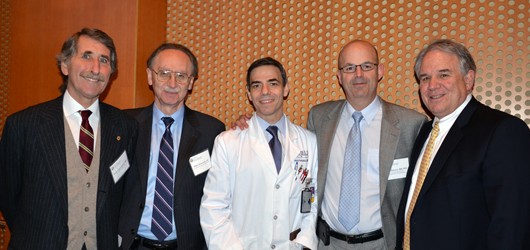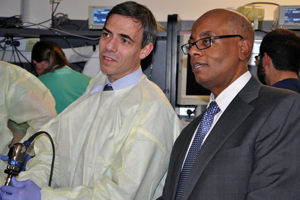
On a day that celebrated the collaboration between neurosurgeons and ear, nose and throat (ENT) surgeons in the challenging arena of endoscopic skull base surgery, the Mayfield Education & Research Foundation and the University of Cincinnati Department of Neurosurgery were privileged to host Paolo Cappabianca, MD, Chairman and Professor of Neurosurgery at the University of Naples, Italy.
Dr. Cappabianca addressed faculty and residents as the 2015 Keller Lecturer in Surgical Neuroanatomy & Research on the UC Medical Center campus and later joined a Resident Training Course in the Department of Otolaryngology-Head & Neck Surgery’s skull base lab. The Keller Lectureship is named for Jeffrey T. Keller, PhD, Research Professor of Neurosurgery & Anatomy and Cell Biology at UC and the Mayfield Clinic.

Dr. Cappabianca spoke about the history, technology, and team approach of endoscopic skull base surgery, a marriage of ENT, or otolaryngology, and neurosurgery. “The performance becomes progressively simplified by the combined suggestion and experience of many,” he said. “Teamwork with ENT surgeons helps during the nasal and sphenoidal steps. It shortens the learning curve for the neurosurgeon and improves the reconstruction phase. Things are better with ENT surgeons. That is why I am close friends with the best ENT guys in the world.”
Skull base surgery, which involves the removal of lesions – typically pituitary or meningioma – from the lower part of the brain, traditionally was performed through an incision (craniotomy) in the skull. In this way, surgeons approached the skull base from above, with the brain’s surface and interior visible in three dimensions.
Increasingly, skull base surgery is performed through the nose with endoscopes, long narrow tools that include a small camera and light. Approaching the lesion through a tiny hole from below presents a different view. Not only is it far smaller, it is impacted further by the endoscope’s two-dimensional presentation. While viewing around hidden corners with angled lenses, surgeons must picture in their mind’s eye the entire region where they are operating, the path they are traveling, and what nerves or arteries are connected to, or lurking behind, the lesion.
Thus the importance of the evolving field of neuroanatomy, which shows surgeons which path is safe and accessible and which landmarks cannot be crossed or touched.
Winding through the anatomy millimeters at a time, Dr. Cappabianca stressed the importance of “staying oriented, remembering all the dangerous landmarks” and being vigilant of anatomical structures that may vary from patient to patient. He punctuated his lecture with time-honored warnings: “You have to respect the sphenopalatine artery … manage prior to damage! … Do not cross the cranial nerves!”
Dr. Cappabianca stressed the need for continued advances in research. “More science means more standardization, increased safety, improved outcome and elimination of the virtuoso,” he said. “Understanding the working area will give you surgical freedom. It will let you exactly know what you can reach and where you can go.”
Dr. Keller, in closing, thanked Dr. Cappabianca for sharing his skill, abilities, knowledge and care for details. “We thank you for demonstrating exquisite clinical anatomy that is essential, and for helping us understand skull base history so that we can know whence we came.”
— Cindy Starr